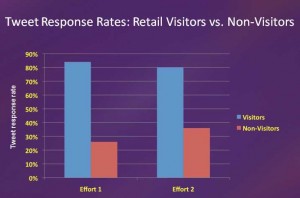I recently compiled the results of a Twitter direct marketing campaign whose goal was to drive traffic to a single retail location. I call it a direct campaign because our strategy was not about mass broadcasting. Instead we were using Twitter search to identify targeted prospects who we reached out to via Twitters @Mentions feature.
We used a CRM tool to track our efforts. It would have been chaotic if we had to dig through the stream or revisit a profile every time we engaged with someone. We kept track of details like:
- Who the prospects were
- Profile URL
- Details of prospects bio and potential influence
- Dates of outbound tweets
- Dates of inbound tweets (responses to our tweets)
- Content of conversations
- Date prospect should be contacted next
We spent just as much time tracking as we did searching, monitoring and engaging, but the end result was worth it. Following is a summary of what the tracking enabled us to do and learn.
Measure Results
Anyone who says that you cant measure the ROI of social media simply hasnt thought out the measurement points and set up a disciplined system for tracking. Of the prospects we delivered offers to, we generated a 32% conversion rate on total visitors and a 10% conversion rate on unique visits. These percentages, which are unheard of in email marketing, speak to the power of targeting, personalization and most importantly, 1:1 relationship marketing.
Identify Opportunities to Improve ROI
By keeping track of our efforts, we were able to uncover a key indicator that a prospect will convert to a visitor. Comparing the response rates of the group that visited the retail location to the non-visitor group enabled us to see that 84% of the visitors responded to our first tweet effort versus only 26% of the non-visitors.

What this possibly points to is an opportunity to increase ROI by investing time only in prospects who respond to our first tweet and shifting more time in searching for targeted propects.

